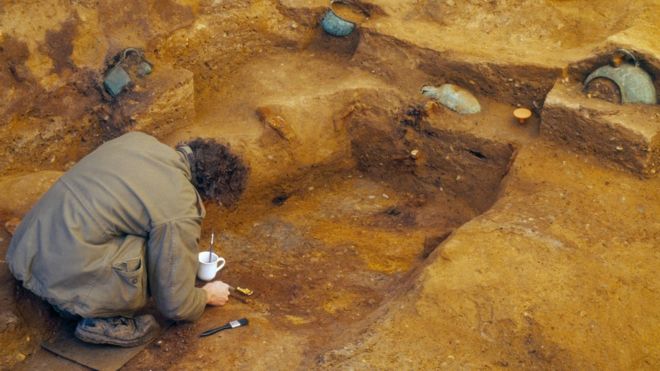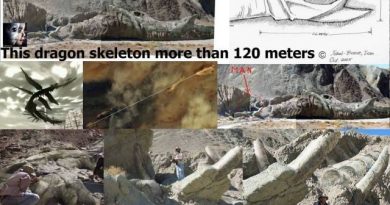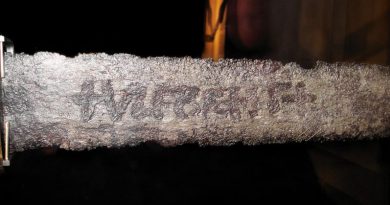UK’s Tutankhamun Burial found between a pub and Aldi supermarket
A royal burial site found between a pub and Aldi supermarket has been hailed as the UK’s answer to Tutankhamun’s tomb. Workers unearthed the grave, which contained dozens of rare artifacts, during roadworks in Prittlewell, near Southend, Essex, in 2003.
Tooth enamel fragments were the only human remains, but experts say their “best guess” is that they belonged to a 6th Century Anglo-Saxon prince. It is said to be the oldest example of a Christian Anglo-Saxon royal burial.
Now, after 15 years of expert analysis some of the artifacts are returning to Southend to go on permanent display for the first time at the Central Museum. When a team from the Museum of London Archaeology (Mola) excavated the site, they said they were “astounded” to find the burial chamber intact.
‘Man of princely lineage’
The remains of the timber structure, which would have measured about 13ft (4m) square and 5ft (1.5m) deep, housed some 40 rare and precious artifacts. Among them was a lyre – an ancient harp – and a 1,400-year-old box thought to be the only surviving example of painted Anglo-Saxon woodwork in Britain.
Gold coins, the gilded silver neck of a wooden drinking vessel, decorative glass beakers and a flagon believed to have come from Syria were also found. Each had been placed within the tomb “as part of a carefully choreographed burial rite”, indicating the resting place of a man of princely lineage, they said.
Locals nicknamed the grave’s unknown occupant the Prince of Prittlewell and the King of Bling because of the riches buried alongside him. Ciara Phipps from Southend Museums Service said the first artefact uncovered – a copper alloy hanging bowl – gave experts a “real idea of just how significant this burial might be”.
“It’s thought it was probably acquired as a gift so it gives a sense of how significant this person might have been… he had friends in high places,” she said. It had been suggested the remains were those of Saebert, Saxon king of Essex from AD604 to AD616 but carbon dating and other tests have indicated the tomb was constructed between AD575 and AD605 – at least 11 years before his death.
Tutankhamun was the son of Akhenaten (formerly Amenhotep IV) and one of Akhenaten’s sisters, or possibly one of his cousins. As a prince, he was known as Tutankhaten. He ascended to the throne in 1333 BC, at the age of nine or ten, taking the throne name Nebkheperure. His wet nurse was a woman called Maia, known from her tomb at Saqqara. His teacher was most likely Sennedjem.
When he became king, he married his half-sister, Ankhesenpaaten, who later changed her name to Ankhesenamun. They had two daughters, neither of whom survived infancy. Computed tomography studies released in 2011 revealed that one daughter was born prematurely at 5–6 months of pregnancy and the other at full-term, 9 months.[ The daughter born at 9 months gestation had spina bifida, scoliosis, and Sprengel’s deformity (a condition affecting the placement of the scapula).
Reign
Given his age, the king probably had very powerful advisers, presumably including General Horemheb (Grand Vizier Ay’s possible son in law and successor) and Grand Vizier Ay (who succeeded Tutankhamun). Horemheb records that the king appointed him “lord of the land” as hereditary prince to maintain law. He also noted his ability to calm the young king when his temper flared.
In his third regnal year, under the influence of his advisors, Tutankhamun reversed several changes made during his father’s reign. He ended the worship of the god Aten and restored the god Amun to supremacy. The ban on the cult of Amun was lifted and traditional privileges were restored to its priesthood. The capital was moved back to Thebes and the city of Akhetaten abandoned.This is when he changed his name to Tutankhamun, “Living image of Amun”, reinforcing the restoration of Amun.
As part of his restoration, the king initiated building projects, in particular at Karnak in Thebes, where he dedicated a temple to Amun. Many monuments were erected, and an inscription on his tomb door declares the king had “spent his life in fashioning the images of the gods”. The traditional festivals were now celebrated again, including those related to the Apis Bull, Horemakhet, and Opet. His restoration stela says:
The temples of the gods and goddesses … were in ruins. Their shrines were deserted and overgrown. Their sanctuaries were as non-existent and their courts were used as roads … the gods turned their backs upon this land … If anyone made a prayer to a god for advice he would never respond.
The country was economically weak and in turmoil following the reign of Akhenaten. Diplomatic relations with other kingdoms had been neglected, and Tutankhamun sought to restore them, in particular with the Mitanni. Evidence of his success is suggested by the gifts from various countries found in his tomb. Despite his efforts for improved relations, battles with Nubians and Asiatics were recorded in his mortuary temple at Thebes. His tomb contained body armor, folding stools appropriate for military campaigns, and bows, and he was trained in archery. However, given his youth (he died c. age 18) and physical disabilities, which seemed to require the use of a cane in order to walk, most historians speculate that he did not personally take part in these battles
After 15 years of research, archaeologists said their “best guess” was that the tomb belonged to Seaxa, Saebert’s brother.
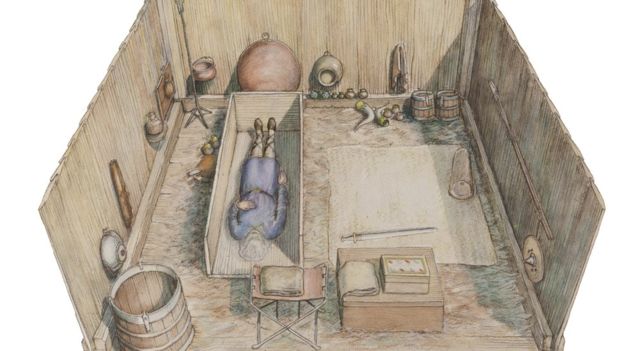
Fit for a prince
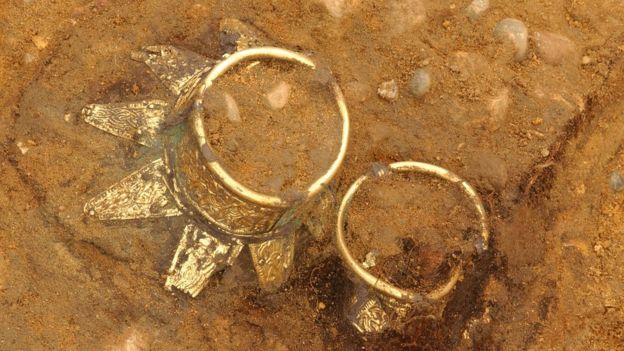
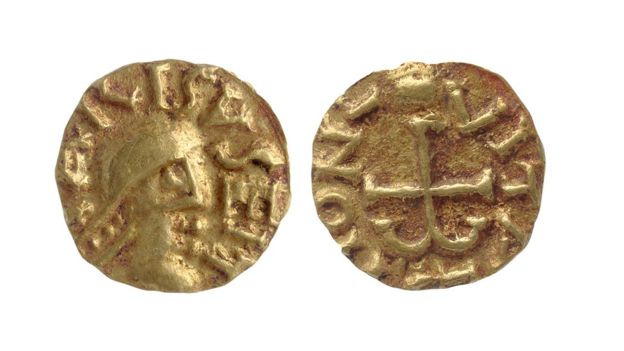
- Gold-foil crosses found at the head of the coffin are thought to have been placed over the eyes – making it certain he was a Christian
- However, other funeral customs, such as the burial mound, grave artefacts and wooden chamber, reflect pre-Christian beliefs and traditions
- A golden belt buckle, likely made especially for the burial, suggested a high-status individual
- An “exceptionally large” ash-wood coffin with an elaborate lid had space for a corpse and other worldly items. It alone would have weighed 160kg
- The size of the coffin, and placement of items within it, suggested he was about 5ft 6in (1.68m) tall
- A folding iron stool, thought to be a gifstol (gift seat) from which a lord dispensed rewards and judgement to his loyal followers and warriors, was found
- A “skilfully crafted sword” with collars of ribbed gold wire on the horn handle and a complex, pattern-welded blade was a clear signal of an aristocratic or royal-status burial.
Source: BBC News
